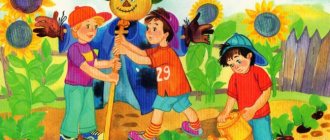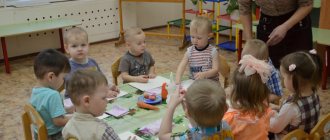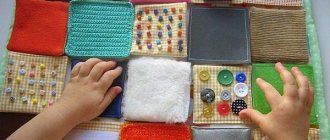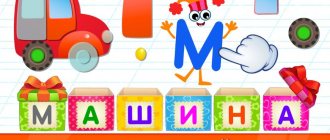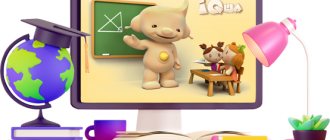Typically, kindergartens teach children 3-4 years old. Working in specialized programs, teachers give young preschoolers there the entire set of knowledge and skills they need. But there are also situations when a child cannot attend this institution or misses a lot due to frequent illnesses. Then the parents take charge of their child’s education themselves. Through systematic developmental activities for children 3-4 years old, even at home, children can learn everything that is appropriate for their age, if you know what and how to teach them.
How educational activities are carried out with children 3-4 years old at home
Homeschooling is a labor-intensive process that requires certain preparation of the parent and the right attitude. To work effectively, you need not only to think through the content of the lessons, but also to awaken the child’s interest in learning. What do you need to know?
Principles of organizing home activities
Any training, home or professional, must be carried out in accordance with the basic principles of pedagogy and take into account the age characteristics of the preschool child. What do you need to know?
- Firstly, for 3-year-old children the leading activity is play. Only by playing can a child be completely immersed in the learning process and firmly grasp the necessary knowledge.
- Secondly, all activities with the child must be systematic. Daily lessons, which are planned in advance, become more difficult as they are learned.
- Thirdly, the child’s activities should constantly change - alternate mental stress with physical exercise and creative tasks.
Conditions for conducting “lessons” for preschool children
At 3 years old, children are already able to concentrate for a long time on an object that interests them, and yet you should not plan too many tasks. The duration of classes for children 3 years old should be no more than 25 minutes, with a mandatory dynamic pause.
Thematic material:
- Educational games for 3 year old boys
- Games for girls 4 years old - educational
It is better to start work when the child has had time to rest and is in a good mood; they usually do it after breakfast or nap, every day at the same time.
While working, nothing should distract the baby’s attention - remove everything unnecessary from the table and out of sight.
Use bright props, handouts and manuals. You can buy them or make them yourself. To avoid losing interest in these learning tools, try not to play with them outside of class.
It’s good if all the exercises in the lesson are united by one plot. This will make it easier to keep the child’s attention.
Take a break from mental stress through physical exercises - dancing to music, walking along a line and an incline, playing with a ball, etc. They need to be included in every lesson.
Objectives and planning
The effectiveness of any work, including pedagogical work, depends on correctly set tasks and a clear plan for their implementation.
The main objectives of developmental activities for children 3-4 years old include the following:
- formation of thinking skills;
- development of motor skills, imagination and creativity;
- improving the sound and semantic aspects of speech, expanding vocabulary;
- formation of ideas about the phenomena and properties of objects, the surrounding world;
- education of personal qualities, teaching norms of behavior.
It is necessary to draw up a plan of developmental activities for children from 3 years old so that different types of activities alternate. Weekly planning will help you understand which exercise should be left, which one should be made more difficult, and which one should be put off for a while.
The principle of constructing classes for preschoolers
All classes for preschool children are based on the principle of playful learning and development. Children better assimilate information that is presented to them unobtrusively, in the form of a game.
Classes should be conducted after a night or daytime sleep - this is the very time when the preschooler is ready to learn new material. The duration of classes should not exceed 25 minutes.
For classes, you need to prepare props, make a plan and think through a scenario. It is better if all the exercises in one lesson are united by a common plot. This could be a certain fairy-tale hero who comes to visit the baby and needs help. The latter helps the guest solve problems and find a way out of the situation, simultaneously learning the material and the necessary knowledge.
Knowledge and skills of children 3-4 years old
A preschooler aged 3-4 years already has a certain experience and set of knowledge. Typically at this age children are able to:
- distinguish and name colors;
- count to 10;
- collect simple puzzles from 4 - 6 parts;
- remove excess items according to specified characteristics;
- see and name inconsistencies;
- memorize easy poems.
When developing a scenario for a lesson with a preschooler, these nuances should be taken into account. Too simple exercises will not arouse interest in the baby, and complex ones, in addition to misunderstanding, can provoke a protest.
Physical development of the child
The main goal is to make the child stronger, more resilient, dexterous, and teach him to coordinate his movements well. Experts recommend doing the following exercises daily:
- stepping over small obstacles;
- walking on an inclined plane;
- jumping over a drawn line (like playing hopscotch);
- walking on a string placed on the floor;
- jumping forward on both legs;
- jumping from low heights.
It is very useful for three-year-old children to swim, dance, play various ball games, ride a bicycle, and perform various exercises on the children's sports wall. Be sure to teach your child to do morning exercises or do fitness with him.
Tasks for the development of children 3-4 years old
When developing a lesson scenario, you can be creative and come up with exercises yourself. Another option is to use ready-made exercises used by teachers in preschool institutions.
Logic and attention
The following exercises will help develop your child’s logic and attention:
- Place 5-6 toys on the table in front of the child. Invite your child to look at them carefully. After this, ask the child to turn away and remove one toy. Let the baby remember and name the toy that is missing. If the child easily copes with the task, then complicate the exercises by removing two toys at a time or increasing their total number.
- Draw and cut out the train. The carriages of a locomotive are various geometric figures moving in a certain sequence. For example: a circle, followed by a square, then a rectangle, etc. Invite your child to continue the logical chain, arranging the trailers in the order you set.
- Prepare pictures of animals, geometric figures or fairy-tale characters. There is one condition - each picture must have a pair. Let the child lay out the pictures and match each one with a pair.
- Invite the baby to solve rhymes - riddles. You read a riddle, and the child says an answer that rhymes with the verse.
Mathematics
At the age of 3-4 years, children already know how to count to 10 , distinguish larger from smaller, short from long, name the basic geometric shapes.
- Give your child pencils and digital coloring books. Let the child color the picture according to the numbers indicating a certain color. At the same time, ask him to pronounce colors and numbers out loud, help the baby if necessary.
- Place toys in front of the baby and offer to count how many there are together. Remove and add toys, changing the total number.
- Invite your baby to count objects selectively. For example, you can count only the apples in the picture or only the animals among the total number of toys.
- Prepare pictures that show objects of different sizes. Let the preschooler name the largest object and the smallest. Ask them to sort the pictures according to the following criteria: from largest to smallest and vice versa.
Speech development
A child of 3 years old can already maintain a dialogue and speak simple sentences. He understands and uses the pronouns “I” and “we”, and can tell what is drawn in the picture.
- Daily articulatory exercises, learning and reciting simple phrases and poems will help improve the sound aspect of speech.
- Show your child the picture and ask him to write a short story based on it.
- "As the animals say." This exercise is relevant both for playing with young children and for classes with preschoolers. Pay special attention to the purity of spoken sounds.
- Read a short fairy tale to your child and ask him to retell the plot.
The world
Children 3 years old already know how to distinguish domestic animals from wild ones, berries from fruits, fish from birds, etc. They name the signs of the seasons and distinguish the time of day .
- When walking with your baby in the park, pay his attention to all the surrounding phenomena: the singing of birds, the rustling of leaves underfoot, the roughness of the bark of the trees, the aroma of flowers. Teach your child to respect nature: to feel the aroma of a flower, you don’t have to pick it - you can bend over to it, trash should be thrown into the trash bin, lawns should not be trampled, etc.
- Show your preschooler various animals and ask him to name which ones are domestic and which are wild. After this, let the child say the names of the cubs of these animals.
- Show your child pictures that depict different seasons and different times of day. Let him name them and explain by what signs he determined this or that time of day or time of year.
Music classes
It is necessary to develop a 3-4 year old child not only mentally, but also physically. Active motor activity accompanied by musical accompaniment has a positive effect on the psycho-emotional mood of a preschooler. Musical classes help instill aesthetic taste, teach you to feel the rhythm and navigate in space.
- Invite your child to dance to different music: rhythmic, melodic, mischievous, sad. Let him not only repeat the movements while dancing, but also learn to hear and convey the mood of a piece of music. Explain that movements should be smooth and measured to slow music, and fast to rhythmic music.
- Learn a children's song with your child and come up with a dance for it together.
- Sing a well-known song to a different tune: cheerful, sad, questioning. Let the baby also try to sing this song, changing the intonation of his voice.
Creation
At the age of 3-4 years, children actively develop their creative abilities. Kids enjoy cutting out, gluing, drawing and making simple crafts under adult supervision.
- Take your child to drawing, modeling from plasticine or salt dough, and appliqué.
- A home puppet theater helps develop a child's imagination. Show your child a fairy tale, and then offer to switch roles. Take the place of the viewer, and give the child the role of director and puppeteer.
- Invite your child to play a role-playing game and act out the plot of a children's fairy tale. It is not necessary to strictly follow the script; improvise with your child and involve new characters in it. You can have your own special and unique fairy tale.
Fine motor skills
Working with your hands helps develop fine motor skills. This could be modeling from plasticine, using mosaics in classes, beads and buttons. During activities that involve the use of small objects, it is necessary to carefully ensure that the child does not bring them to his mouth and taste them.
- Invite your child to create a picture from cereals. To do this, prepare in advance: cardboard with a pattern printed on it, glue, cereal. Carefully apply glue to a certain area of the drawing and let the child sprinkle cereal on this area. Shake off the excess and move on to the next element of the design. To depict the road, use buckwheat, for the sun - millet, flowers can be drawn with curly pasta or beans. Imagine and create with your child.
- Prepare the following items: a plastic bag, a plastic toy, a soft toy, a mitten, a cube. Ask your baby to close his eyes. One by one, give him objects in his hands and ask him to determine what they are. Let the baby carefully touch the object and say what it is: smooth, cold, rustling, fluffy. The set of items can be changed at your discretion.
- Finger exercises help develop fine motor skills.
Classes for children 3-4 years old should be aimed at the all-round development of the preschooler. Any, even minor, achievement of a child should be celebrated and encouraged. If some exercises are difficult for him, you should suggest and help without expressing your dissatisfaction. The right approach to organizing and conducting classes will help develop the child’s cognitive activity and lay the foundation for a future positive attitude towards acquiring new knowledge.
Speech development
Normally, a three-year-old child speaks about 1000 words well and can already speak well, so special attention should be paid to speech development. What can you do?
- Communicate with your child as much as possible, be interested in what he says.
- Perform articulation exercises daily. This will help you place the speech sounds correctly.
- Discuss the story pictures. A collection of fairy tales by Vladimir Suteev is ideal for classes.
- Learn poems and songs. Poetic riddles are a hit with kids.
Speech development is positively influenced by games and exercises that involve fine motor skills , for example:
- all kinds of games with cereals, beans, buttons, sand, shells, pasta, etc.;
- fastening buttons, lacing;
- finger gymnastics;
- origami;
- games with water.
Musical activities help develop speech hearing: singing, guessing familiar sounds, playing musical instruments, guessing songs, singing vowel sounds.

